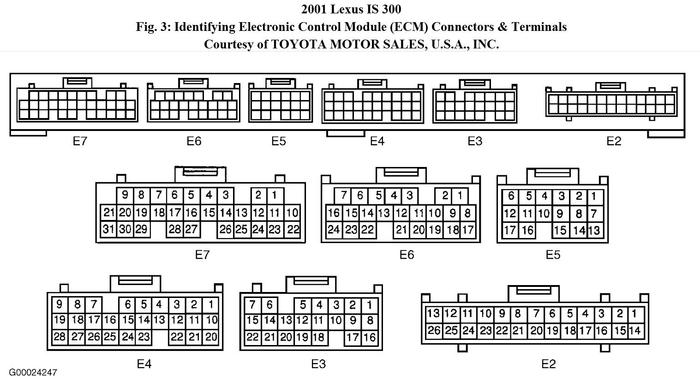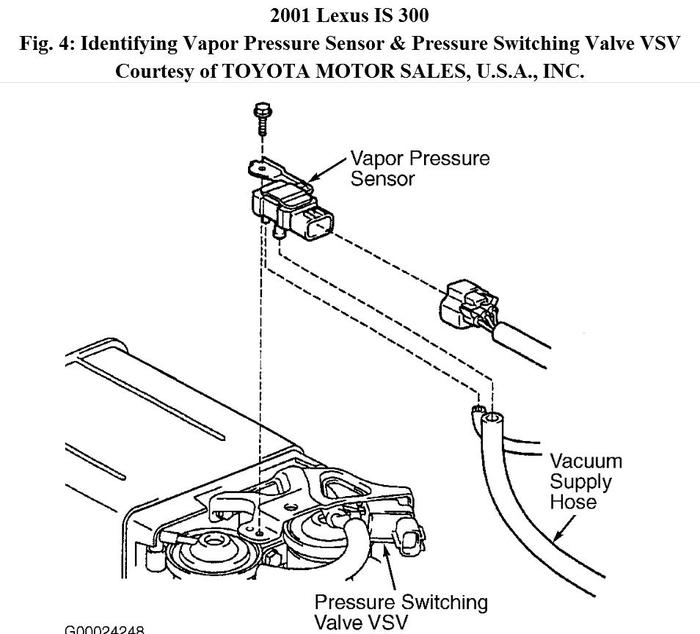See if you are able to perform the following.
DTC P0440: EVAP SYSTEM MALFUNCTION
CAUTION:
If ECM replacement is instructed in following testing, always ensure ECM harness connector and ground circuit are okay. If either are suspect, repair and repeat testing to confirm ECM malfunction. If ECM is replaced, ECM must be programmed with proper ignition key code for engine immobilizer system.
NOTE:
Vapor canister and some related components can be accessed through trunk by removing trunk floor mat and protective access cover at front of trunk.
Circuit Description
Vapor pressure sensor, canister closed valve Vacuum Switching Valve (VSV) and pressure switching valve VSV are used to detect faults in EVAP system. ECM determines if a fault is present in EVAP system based on vapor pressure signal circuit. DTC P0440 is set if EVAP system leak is detected in EVAP system components between fuel tank and charcoal canister or vapor pressure sensor malfunctions.
Possible causes are:
l Hose between fuel tank and charcoal canister damaged.
L Fuel tank cap installed incorrectly.
L Fuel tank cap defective.
L Damaged, disconnected or blocked vacuum hose.
L Fuel tank damaged.
L Charcoal canister damaged.
L Open or short in vapor pressure sensor circuit.
L Faulty vapor pressure sensor.
L Fuel tank overfill check valve damaged.
L Faulty ECM.
Diagnostic Aids
NOTE:
If DTC P0441, P0446, P0450 or P0451 is output after DTC P0440, perform appropriate circuit test first before performing DTC
P0440 test.
Diagnosis & Repair
1. Check with vehicle driver if fuel tank cap was found loose at any time. If fuel tank cap was loose, it probably was cause of DTC P0440 to set. If fuel tank cap was not loose, check for cracks, deformations or loose connections in following:
l Fuel tank.
L Faulty charcoal canister.
L Fuel tank filler pipe.
L Hose and tubes around fuel tank and charcoal canister.
Repair as necessary. If components are okay, go to next step.
2. Check if fuel tank cap is an original manufacturer's cap. If fuel tank cap is an original manufacturer's cap, go to next step. If fuel tank cap is not an original manufacturer cap, replace cap with a manufacturer's cap.
3. Check if fuel tank cap is installed properly. Reinstall fuel cap as necessary. If fuel cap is installed properly, go to next step.
4. Check for damaged fuel tank cap and gasket. Replace fuel cap as necessary. If fuel cap and gasket are okay, go to next step.
5. Remove fuel tank cap. Visually inspect fuel tank filler neck for damage. Replace filler neck as necessary. If filler neck is okay, go to next step.
6. Check vacuum hoses between vapor pressure sensor and fuel tank, charcoal canister and pressure switching valve VSV, and between vapor pressure sensor and charcoal canister. Check hoses for correct installation, looseness and damage. Repair as necessary. If vacuum hoses are okay, go to next step.
7. Check hose and tube between fuel tank and charcoal canister for correct installation and damage. Repair as necessary. If hose and tube are okay, go to next step.
8. Visually inspect charcoal canister for cracks or damage. Replace canister as necessary. If canister is okay, go to next step.
9. Access ECM under protective cover, behind left headlight in engine compartment. Turn ignition on. Backprobing, measure voltage between terminals No. 2 (Blue/Yellow wire) and No. 18 (Brown wire) at ECM E6 connector. See Fig. 3. If voltage is 4.5-5.5 volts, go to next step. If voltage is not 4.5-5.5 volts, replace ECM and retest system.
NOTE:
DO NOT apply more than 19.7 in. Hg of vacuum to vapor pressure sensor.
10. Locate vapor pressure sensor mounted on vapor canister. See Fig. 4. Sensor has a Black 3-pin connector with Brown, Blue/Yellow and Pink/Green wires. Disconnect vacuum supply hose (hose closest to electrical connector) from vapor pressure sensor. Backprobing ECM harness connector, connect voltmeter between terminal No. 18 (Pink/Green wire) at ECM E4 connector and terminal No. 18 (Brown wire) at ECM E6 connector. See Fig. 3. Connect a vacuum pump to sensor. Voltage should be 2.9-3.7 volts without vacuum applied, and.5
volt or less with 1.18 in. Hg (4.0 kPa) applied. If voltage is as specified, go to step 12. If voltage is not as specified, go to next step.
11. Check for an open or short in wiring harness between vapor pressure sensor and ECM. Repair as necessary. If wiring is okay, replace vapor pressure sensor.
12. Check fuel tank and fuel tank overfill check valve for cracks and damage. Overfill check valve is located on top of fuel tank. Replace fuel tank or overfill check valve as necessary. If fuel tank and overfill check valve are okay, probable cause of DTC P0440 to set was an incorrectly installed fuel tank cap.
Images (Click to make bigger)
SPONSORED LINKS
Sunday, December 16th, 2012 AT 10:30 PM






